#ok in my defense
Text

Idk I'm not over hookhausen yet
#hook aew#danhausen#jungle boy#wrestling nonsense#ok in my defense#im coming off of covid#and i think im hilarious
32 notes
·
View notes
Text

I dunno how to caption this but I wanted to know what he’d look like with a beard so i tried my best 😭
#ok in my defense#I didnt really feel like messing with the brushes too much to make it accurate#cuz its late#anyway#hercules#hercules 1997#my edits#nats edits#my art#kind of#nats art
8 notes
·
View notes
Text
how the scara funds are looking right now 💔

#ok in my defense#im at 75 pity#and i’m not pulling anymore#and saving this for scara’s banner#so in about 5 ish pulls i’ll pull a 5 star so fingers crossed it’s scara#if i lose the 50/50 tho 🥲#then me and my 20 wishes are going strong 😻😻😻😻😻😻
12 notes
·
View notes
Text
Things I have done tonight:
Had a coffee at 1:30am
Went to bed at 2am
Woke up at 5am
Currently am still awake at 7:55am
Like hmmmm I wonder if any of this is related to the first thing I did.
#ok in my defense#caffeine doesn’t keep me up#it helps me focus#so like#I didn’t think it was going to do this#technically I made good choices#personal
2 notes
·
View notes
Text


@percentstardust
#OK IN MY DEFENSE#ive been working on this blog for a few weeks!#i started watching THT while making it so paused it to quickly made june's blog#cause i knew i could made a single muse blog for june in like...a day ( which i did )#so ive been working on this one for a bit it's just taking a while cause these are characters based off of original lore#― ⠀ ⠀ ⠀ ⠀ ⠀ ⠀ooc ⠀ ❯ ⠀ 🌺
2 notes
·
View notes
Text

What’s better than one procrastinator drawing? 2 procrastination drawings!!!
#drawing#fantasy#mushrooms#procastination#let’s gooooo#ok in my defense#i am listening to review videos while drawing#so it’s semi productive#also#how do you draw rain???#digital art
0 notes
Text

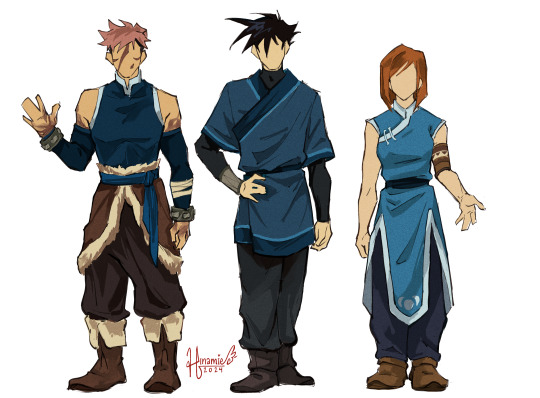
obligatory water tribe alt outfits so i am not held liable if they freeze
jjk atla!au with @philosophiums
#my art#jujutsu kaisen#jjk#itadori yuuji#fushiguro megumi#kugisaki nobara#fanart#jjk fanart#jjk atla!au#lmhs#atla!au: art#atla!au: design#head in hands yuuji is just wearing korra's outfit i realized too late thats just her s4 fit.......#THE ARMBANDS AND SLEEVELESS TOP HAVE TO STAY#theyre SO necessary . but they r also The Problem :<#though in my defense theres rly not a whole lot of options 2 make each culture's clothing look visually distinct Within that culture#the colours and silhouettes r all so similar there r only so many combinations i can frankenstein tgt...#it makes Not accidentally copying an existing design so difficult#im trying my best out here :(#though it would have been nice if i didnt rip off . u kno. the PROTAg#sighs gomen korra im plagiarizing. yuuji keep ur coat on.#i do like their outdoor fits better tbh so maybe it will b ok#or maybe i will rework. we shall see
2K notes
·
View notes
Text
Always an experience watching the leftism leave FNAF fans when someone mentions that Scott Cawthon financially backed fascist politicians.
The switch from posting hardline leftist tweets about boycotts and signal boosts and critical takedowns of politicians and celebrities to ‘ohhh, well. everyone makes mistakes. who can blame him, listen he. he donated money to gay charities too. that makes it ok! a millionaire in his forties is allowed to have political beliefs. does it even matter? just let it go!’ is whiplash inducing. The antivaxxer celebrities have got to go, but this one horror dev who quietly handed wads of cash to antivax lawmakers? He’s chill, he can stay.
The charity thing is so funny too because suddenly utilitarian positive-negative point counting is the way to go. Maybe an abacus would help calculate the net good of donating to the Trevor Project minus donating thousands of dollars to Mitch McConnell and Donald Trump. -10 points if I push a kid in a lake but +11 points if I help an old lady across the street, so I’m chill. You can’t judge me. Hey, maybe. Just don’t push a kid in the lake period. How fucking low is the bar when we’re excusing maxing out the possible dollar amount of donations to Mitch fucking McConnell. That should be like. Default you’re a bad person.
#delete later#personal#not art#rant#you can still be a fan of fnaf 100% but god you’re not obligated to defend its creator#don’t pretend like Scott is cool#“’Scott likes gay people he only voted for trump for his fiscal and defense policies in defendi america from terrorists!’#kid. that’s not good either.#fiscal conservatism kills people too.#the whole thing exposes how weak some leftists are to the image of the ‘well-mannered right wing republican.’ the type who would#respectfully disagree with your right to exist with a kind top of the hat#‘as long as you silently hate me and force a nice smile while shaking my hand it’s ok’#this is why jk Rowling is hated while Scott gets a free pass. just have to hide your hate well enough and liberals will excuse you ig
3K notes
·
View notes
Text
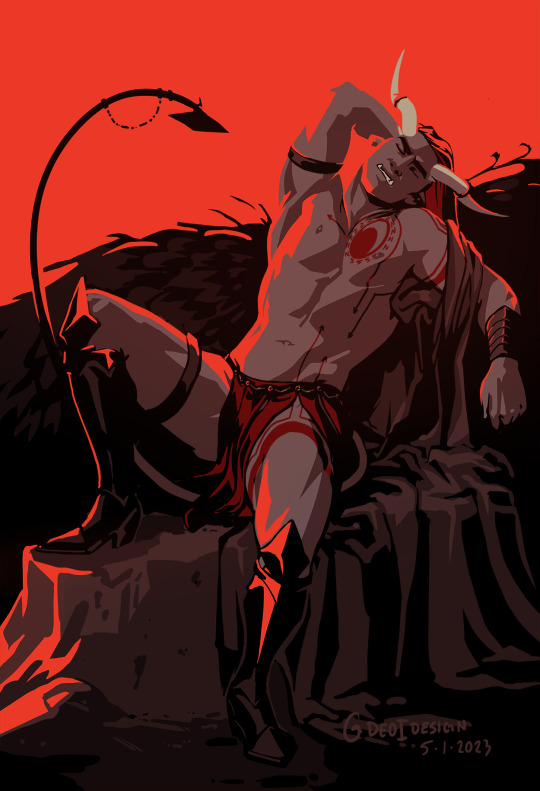
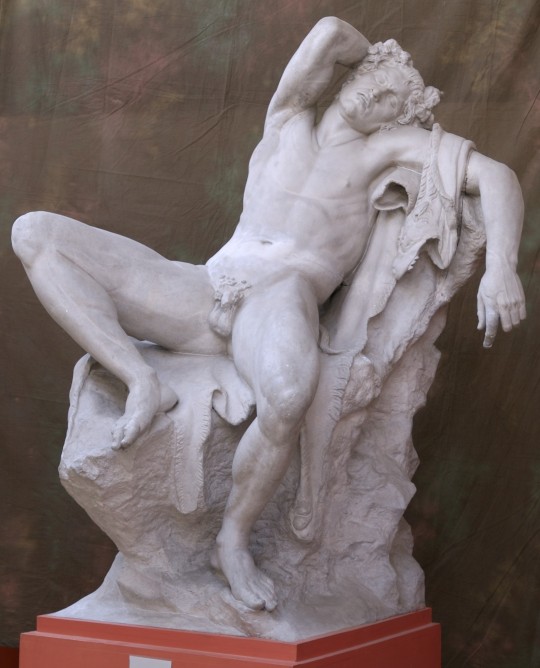
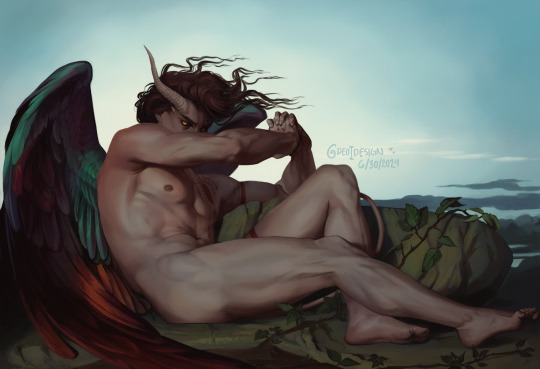
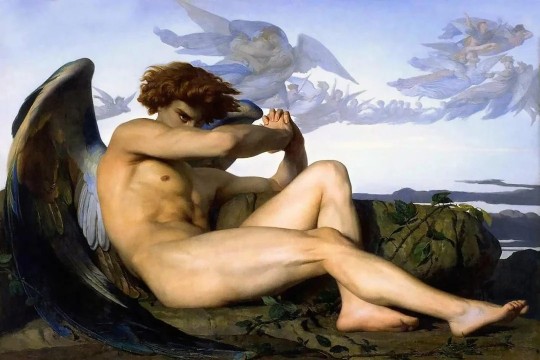
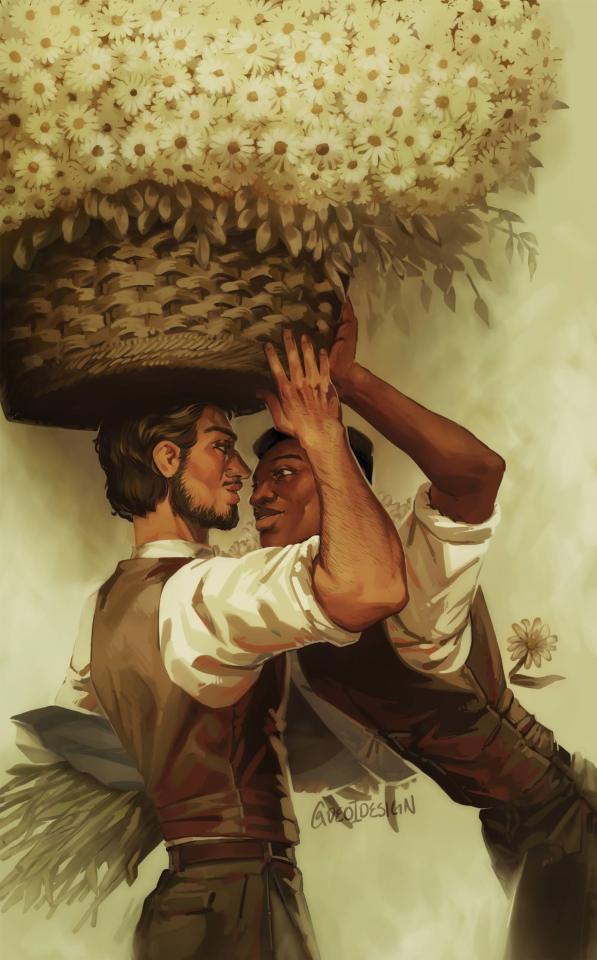
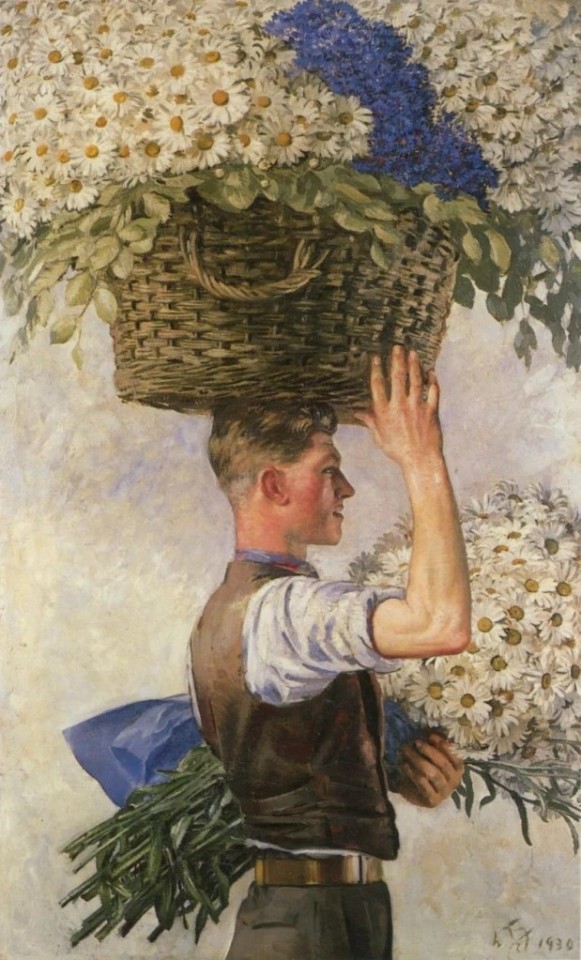
Doing master studies the only way I know how: Stealing them and making them my guys.
(Barberini Faun)
(The Fallen Angel - Alexandre Cabanel)
(Covent Garden - William Bruce Ellis Rankin)
#obviously. not actually theft...#i was gonna say these are public domain but covent garden actually isnt yet#it will be. in two years.#thats the most different one though like i added a whole new guy..#maybe not the most different. barberini faun is pretty different i just took the post#pose#its barely even a study. thats not true#but. what was i saying.#oh its not theft it's study... the purpose is to learn!!! but also. if im gonna spend like 2 days on something...#its GONNA be my guys#otherwise. idk. i only want to spend 30 or so minutes per study#just to get the notes down and the practice for the skill im working on#i dont get all that much more out of completely rendering a master study. PERSONALLY.#at least definitely not enough to be worth taking 100x longer#but making them my characters makes it worth going all the way!!!#plus it's good practice w like. not just going 1:1 but actually genuinely interpreting whats there so i can manipulate it...#again. personally. this is just how i worm#WORK#youd better worm bitch#uhm... anyways yeah. ive done lots of study but why TF share it LMAO i dont even save it#its just to learn. ive got 1 million other drawings to save and look at later.#once the learning is done it's done its job and i have no need anymore#this is why the only studies i have are from school. i had to save and upload them#well. ok also i dont study as much now BUT in my defense im a full time artist#an hour or so a week is different ok im learning while working too.. i learned how to learn and i do it all the time now#master studies#digital art#my art#illustration#my ocs
458 notes
·
View notes
Text


so. this’ll never be real but i think it’d be silly if kazuma got a small white snake. just to hang out with
#please give name suggestions#for the sillies#tgaa#tgaa chronicles#tgaac#great ace attorney#the great ace attorney#dgs#do you think van zieks would like the snake or freak out#maybe i should flip a coin#or do more research on how he’s like#kazuma asogi#kazuma asougi#ryunosuke naruhodo#ryunosuke mention ohhh#asoryuu#if you squint#serpent kazuma#he’s not here but it’s my target audience ok#snake kazuma#dai gyakuten saiban#tgaa2#tgaa2 spoilers#dgs2#dgs2 spoilers#look i made a thing#in my defense snakes are kinda cute#also it’s a little ironic considering g1-2 but it adds to the experience ok#don’t pay attention to the colors i chose for kazuma too much bc i don’t like it#art
331 notes
·
View notes
Text

Lord of The Barrens

Saint Sebastian by Carlo Dolci
#my art#vampires#blood tw#digital art#oc: nate#ok in my defense#this was a dare#the shading doesn't show as well as i'd like but i promise it looks good
3 notes
·
View notes
Text
Hey so can we like stop with the "Zutara is for the girls and Kataang is for the boys" thing. It's silly and it's breakdancing just on the edge of gender essentialism.
The assumption that there is something inherent to Zutara that appeals predominantly to women and Kataang that appeals predominantly to men is dishonest because every ship can have appeal to all genders.
The discussion of the "female gaze" in Zutara and the "male gaze" in Kataang is also redundant. I enjoy dissecting the concept of "the gaze", however it is important to note that the "female gaze" doesn't have a set definition or grouping of conventions it adheres to. Lisa French, Dean of RMIT University’s School of Media and Communication says:
“The female gaze is not homogeneous, singular or monolithic, and it will necessarily take many forms... The aesthetic approaches, experiences and films of women directors are as diverse as their individual life situations and the cultures in which they live. The "female' gaze” is not intended here'to denote a singular concept. There' are many gazes."
Now excuse me as I put on my pretentious humanistics student hat.
Kataang's appeal to women and the female gaze
Before I start, I want to note that the female gaze is still a developing concept
There are very few female film directors and writers, and most of them are white. The wants and desires of women of colour, the demographic Katara falls into, are still wildly underepresented. Additionally, the concept of the female gaze had many facets, due to it being more focused on emotional connections rather than physical appearance as the male gaze usually is. Which means that multiple male archetypes fall into the category of "for the female gaze".
The "female gaze" can be best described as a response to the "male gaze", which was first introduced by Laura Mulvey in her paper: "Visual Pleasure and Narrative Cinema" , however the term "male gaze" itself was not used in the paper.
Mulvey brought up the concept of the female character and form as the passive, objectified subject to the active voyeuristic male gaze, which the audience is encouraged to identify, usually through the male character.
To quote her:
"In a world ordered by sexual imbalance', pleasure' in looking has been split between active'/male' and passive/female'. The determining male gaze' projects its fantasy onto the female' figure', which is styled accordingly."
Mulvey also brings up the concept of scopopfillia (the term being introduced by Freud), the concept of deriving sexual gratification from both looking and being looked at. This concept has strong overtones of voyeurism, exhibitionism and narcissism, placing forth the idea that these overtones are what keeps the male viewer invested. That he is able to project onto the male character, therefore being also able to possess the passive female love interest.
However, it's important to note that Mulvey's essay is very much a product of its times, focused on the white, heterosexual and cisgender cinema of her time. She also drew a lot of inspiration from Freud's questionable work, including ye ole penis envy. Mulvey's paper was groundbreaking at the time, but we can't ignore how it reinforces the gender binary and of course doesn't touch on the way POC, particularly women of colour are represented in film.
In her paper, Mulvey fails to consider anyone who isn't a white, cis, heterosexual man or woman. With how underrepresented voices of minorities already are both in media and everyday life, this is something that we need to remember and strive to correct.
Additionally Mulvey often falls into gender essentialism, which I previously mentioned at the beginning of this post. Funny how that keeps coming up
"Visual Pleasure and Narrative Cinema" started a very interesting and important conversation, and I will still be drawing from certain parts of it, however huge swathes of this text have already become near archaic, as our culture and relationship with media evolves at an incredible pace.
And as filmaking evolves, so does our definition of the male and female gaze. So let's see what contemporary filmakers say of it.
In 2016, in her speech during the Toronto International Film Festival , producer of the TV series Transparent, Jill Soloway says:
“Numero uno, I think the Female Gaze is a way of “feeling seeing”. It could be thought of as a subjective camera that attempts to get inside the protagonist, especially when the protagonist is not a Chismale. It uses the frame to share and evoke a feeling of being in feeling, rather than seeing – the characters. I take the camera and I say, hey, audience, I’m not just showing you this thing, I want you to really feel with me.
[Chismale is Soloway's nickname for cis males btw]
So the term "female gaze" is a bit of a misnomer, since it aims to focus on capturing the feelings of characters of all genders. It's becoming more of a new way of telling stories in film, rather than a way to cater to what white, cisgender, heterosexual women might find attractive in a man.
Now, Aang is the decided protagonist of the show, however, Atla having somewhat of an ensemble cast leads to the perspective shifting between different characters.
In the first episode of atla, we very much see Katara's perspective of Aang. She sees him trapped in the iceberg, and we immediately see her altruism and headstrong nature. After she frees Aang, we are very much first subjected to Katara's first impressions of him, as we are introduced to his character. We only see a sliver of Aang's perspective of her, Katara being the first thing he sees upon waking up.
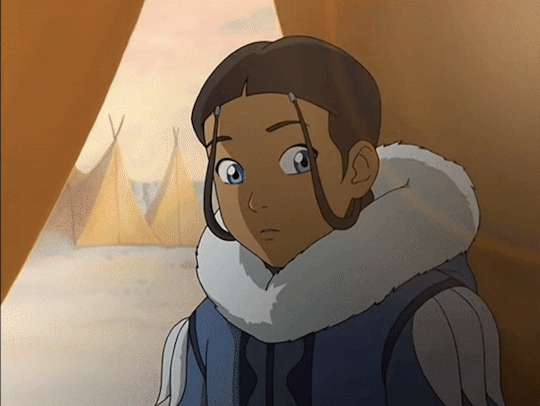
We see that she is intrigued and curious of him, and very excited about his presence. She is endeared and amused by his antics. She is rediscovering her childish side with his help. She is confiding in him about her own trauma surrounding the Fire Nation's genocide of the Southern Waterbenders. She is willing to go against her family and tribe ans leave them behind to go to the Northern Water Tribe with Aang. We also see her determination to save him when he is captured.
As the show moves on and the plot kicks into gear, we do shift more into Aang's perspective. We see his physical attraction to her, and while we don't see Katara's attraction quite as blatantly, there are hints of her interest in his appearance.

This is where we get deeper into the concept of Aang and Katara's mutual interest and attraction for one another. While her perspective is more subtle than most would like, Katara is not purely an object of Aang's desire, no more than he is purely an object of her desire.
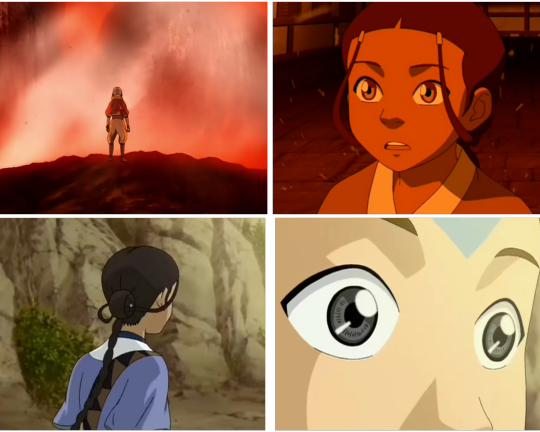
When analysing this aspect of Katara and Aang's relationship, I couldn't help but be reminded of how Célene Sciamma's Portrait of a lady on fire (in my personal opinion, one of the best studies of the female gaze ever created) builds up its romance, and how it places a strong emphasis on the mutuality of the female gaze.
Portrait of a lady on fire's cinematography is very important to the film. We see the world through the perspective of our protagonist, a painter named Marianne. We also see her love interest, Héloïse, the woman whom she is hired to paint a portrait of, through Marianne's lense.
We see Marianne analyse Héloïse's appearance, her beauty. We look purely through Marianne's eyes at Héloïse for a good part of the movie, but then, something unexpected happens. Héloïse looks back. At Marianne, therefore, in some way, also at the audience. While Marianne was studying Héloïse, Héloïse was studying Marianne.
We never shift into Héloïse's perspective, but we see and understand that she is looking back at us. Not only through her words, when she for example comments on Marianne's mannerisms or behaviours, but also hugely through cinematography and acting of the two amazing leads. (Noémie Merlant as Marianne and Adèle Haenel as Héloïse. They truly went above and beyond with their performances.)
This is a huge aspect of the female gaze's implementation in the film. The camera focuses on facial expressions, eyes and body language, seeking to convey the characters' emotions and feelings. There's a focus on intense, longing and reciprocated eye contact (I have dubbed this the Female Gays Gaze.). The characters stand, sit or lay facing each other, and the camera rarely frames one of them as taller than the other, which would cause a sense of power imbalance.
The best way to describe this method of flimaking is wanting the audience to see the characters, rather than to simply look at them. Sciamma wants us to empathise, wants us to feel what they are feeling, rather than view them from a distance. They are to be people, characters, rather than objects.
Avatar, of course, doesn't display the stunning and thoughtful cinematography of Portrait of a Lady on Fire, and Katara and Aang's relationship, while incredibly important, is only a part of the story rather than the focus of it.
However, the 'Kataang moments' we are privy to often follow a similar convention to the ones between Marianne and Héloïse that I mentioned prior.
Theres a lot of shots of Katara and Aang facing each other, close ups on their faces, particularly eyes, as they gaze at one another.
Katara and Aang are often posited as on equal grounds, the camera not framing either of them as much taller and therefore more powerful or important than the other. Aang is actually physically shorter than Katara, which flies in the face in usual conventions of the male fantasy. (I will get to Aang under the male gaze later in this essay)
And even in scenes when Aang is physically shown as above Katara, particularly when he's in the Avatar state, Katara is the one to pull him down, maintaining their relationships as equals.
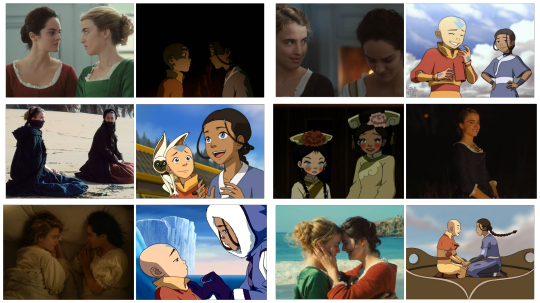
Despite most of the show being portrayed through Aang's eyes, Katara is not a passive object for his gaze, and therefore our gaze, to rest upon. Katara is expressive, and animated. As an audience, we are made aware that Katara has her own perspective. We are invited to take part in it and try to understand it.
Not unlike to Portrait of a Lady on Fire, there is a lot of focus placed on mannerisms and body language, an obvious example being Katara often playing with her hair around Aang, telegraphing a shy or flustered state. We also see her express jealousy over Aang, her face becoming sour, brows furrowed. On one occasion she even blew a raspberry, very clearly showing us, the audience, her displeasure with the idea of Aang getting attention from other girls.
Once again, this proves that Katara is not a passive participant in her own relationship, we are very clealry shown her perspective of Aang. Most of the scenes that hint at her and Aang's focus on their shared emotions, rather than, for example, Katara's beauty.
Even when a scene does highlight her physical appearance, it is not devoid of her own thoughts and emotions. The best example of this being the scene before the party in Ba Sing Se where we see Katara's looking snazzy in her outfit. Aang compliments her and Katara doesn't react passively, we see the unabashed joy light up her face, we can tell what she thinks of Aang's comment.
In fact, the first moment between Katara and Aang sets this tone of mutual gaze almost perfectly. Aang opens his eyes, and looks at Katara. Katara looks back.
There is, once again, huge focus on their eyes in this scene, the movement of Aang's eyelids right before they open draws out attention to that part of his face. When the camera shows us Katara, is zooms in onto her expression as it changes, her blinking also drawing attention to her wide and expressive eyes.

This will not be the first time emphasis is placed on Katara and Aang's mutual gaze during a pivotal moment in the show. Two examples off the top of my head would be the Ends of B2 and B3 respevtively. When Katara brings Aang back to life, paralleling the first time they laid eyes on one another. And at the end of the show, where their gaze has a different meaning behind it.
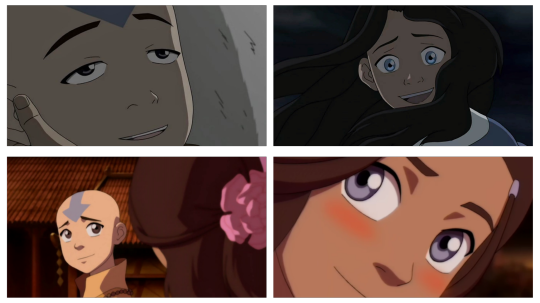
We see Katara's emotions and her intent telegraphed clearly in these instances.
In Book 1, we see her worry for this strange bald boy who fell out of an iceberg, which melts away to relief and a hint of curiosity once she ascertains that he isn't dead.
In B2 we once again see worry, but this time it's more frantic. Her relationship with Aang is much dearer to her heart now, and he is in much worse shape. When we see the relief on her face this time, it manifests in a broad smile, rather than a small grin. We can clearly grasp that her feelings for Aang have evolved.
In B3, we step away from the rule because Aang isn't on the verge of death or unconsciousness for the first time. It is also the first time in a situation like this that Aang isn't seeing Katara from below, but they are on equal footing. I attribute this to symbolising change of pace for their relationship.
The biggest obstacle in the development of Katara and Aang's romance was the war, which endangered both their lives. Due to this, there was a hesitance to start their relationship. In previous scenes that focused this much on Aang and Katara's mutual gaze, Aang was always in a near dead, or at least 'dead adjacent' position. This is is a very harsh reminder that he may very well die in the war, and the reason Katara, who has already endured great loss, is hesitant to allow her love for him to be made... corporeal.
However, now Aang is standing, portraying that the possibily of Katara losing him has been reduced greatly with the coming of peace, the greatest obstacle has been removed, and Katara is the one to initiate this kiss.
Concurrently, Katara's expression here does not portray worry or relief at all, because she has no need to be worried or relieved. No, Katara is blushing, looking directly at Aang with an expression that can be described as a knowing smile. I'd argue that this description is accurate, because Katara knows that she is about to finally kiss the boy she loves.
Ultimately, Katara is the one who initiates the kiss that actually begins her and Aang's romantic relationship.

Kataang's appeal to women is reflected in how Katara is almost always the one to initiate physical affection with Aang. With only 3 exceptions, one of which, the Ember Island kiss being immediately shown by the narrative as wrong, and another being a daydream due to Aang's sleep deptivation. The first moment of outwardly romantic affection between Aang and Katara is her kissing his cheek. And their last kiss in the show is also initiated by Katara.
I won't falsely state that Kataang is the perfect representation of the female gaze. Not only because the storyline has its imperfections, as every piece of media has. But also because I simply belive that the concept of the female gaze is too varied and nebulous to be fully expressed. With this essay, I simply wanted to prove that Kataang is most certainly not the embodiment of catering to the male gaze either. In fact it is quite far from that.
The aspects of Kataang that fall more towards embodying the female gaze don't just appeal to women. There's a reason a lot of vocal Kataang shippers you find are queer. The mutual emotional connection between Katara and Aang is something we don't have to identify with, but something we are still able to emphasise with. It's a profound mutual connection that we watch unfold from both perspectives that sort of tracends more physical, gendered aspects of many onscreen romances. You just need to see instead of simply look.
✨️Bonus round✨️
Aang under the gaze
This started off as a simple part of the previous essay, however I decided I wanted to give it it's own focus, due to the whole discourse around Aang being a wish-fullfilling self insert for Bryke or for men in genral. I always found this baffling considering how utterly... unappealing Aang is to the male gaze.
It may surprise some of you that men are also subjected to the male gaze. Now sadly, this has nothing to do with the male gaze of the male gays. No, when male characters, usually the male protagonist, are created to cater to the male gaze, they aren't portrayed as sexually desirable passive objects, but they embody the active/masculine aide of the binary Laura Mulvey spoke of in the quote I shared at the beginning of this essay.
The protagonist under the male gaze is not the object of desire but rather a character men and boys would desire to be.
They're usually the pinnacle of traditional, stereotypical masculinity.
Appearance wise: muscular but too broad, chiseled facial features, smouldering eyes, depending on the genre wearing something classy or some manner of armour.
Personalitywise they may vary from the cool, suave James Bond type, or a more hotblooded forceful "Alpha male" type. However these are minor differences in the grand scheme of things. The basis is that this protagonist embodies some manner of idealised man. He's strong, decisive, domineering, in control, intimidating... you get the gist. Watch nearly any action movie. There's also a strong focus placed on having sway or power over others. Often men for the male gaze are presented as wealthy, having power and status. Studies (that were proved to be flawed in the way the data was gathered, I believe) say that womem value resources in potential male partners, so it's not surprising that the ideal man has something many believe would attract "mates". [Ew I hated saying that].
Alright, now let's see how Aang holds up to these standards.

Well... um...
Aang does have power, he is the Avatar. However, he is often actually ignored, blown off and otherwise dismissed, either due to his age or his personality and ideals being seen as unrealistic and foolish. Additionally, Aang, as a member of a culture lost a century ago, is also often posited as an outsider, singled out as weak, his beliefs touted as the reason his people died out and.
Physically, Aang doesn't look like the male protagonist archetype, either. He isn't your average late teens to brushing up against middle aged. Aang is very much a child and this is reflected in his soft round features, large eyes and short, less built body. This is not a build most men would aspire to. Now, he still has incredible physical prowess, due to his bending. But I'm not sure how many men are desperate to achieve the "pacifist 12 year old" build to attract women.
Hailing from a nation that had quite an egalitarian system, Aang wouldn't have conventional ideas surrounding leadership, even if he does step up into it later. He also has little in the way of possessions, by choice.
As for Aang's personality, well...

I mean I wouldn't exactly call him your average James Bond or superhero. Aang is mainly characterised through his kindness, empathy, cheerful nature and occasional childishness (which slowly is drained as the trauma intesifies. yay.)
Aang is very unwilling to initiate violence, which sets him aside from many other male protagonists of his era, who were champing at the bit to kick some ass. He values nature, art, dance and fun. He's in tune with his emotions. He tries to desecalate situations before he starts a fight.
Some would say many of Aang's qualities could be classified as feminine. While the other main male characters, Zuko and Sokka try to embody their respective concepts of the ideal man (tied to their fathers), Aang seems content with how he presents and acts. He feels no need to perform masculinity as many men do, choosing to be true to his emotions and feelings.
These "feminine" qualities often attract ridicule from other within the show. He is emasculated or infantiliased as a form of mockery multiple times, the most notable examples being the Ember Island play and Ozai tauntingly referring to him as a "little boy". Hell, even certain Aang haters have participated in this, for example saying that he looks like a bald lesbian.
I'd even argue that, in his relationships with other characters, Aang often represents the passive/feminine. Especially towards Zuko, Aang takes on an almost objectified role of a trophy that can be used to purchase Ozai's love. [Zuko's dehumanisation of others needs to be discussed later, but it isn't surprising with how he was raised and a huge part of his arc is steerring away from that way of thinking.]
Aang and Zuko almost embody certain streotypes about relationships, the forceful, more masculine being a literal pursuer, and the gentler, more feminine being pusued.
We often see Aang framed from Zuko's perspective, creating something akin to the mutual gaze of Katara and Aang, hinting at the potential of Zuko and Aang becoming friends, a concept that is then voiced explicitly in The Blue Spirit.
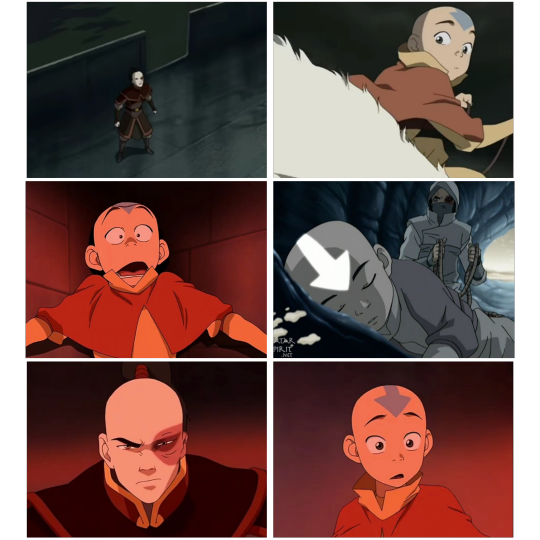
However, unlike Katara, Zuko is unable to empathise with Aang at first, still seeing Aang as more of an object than a person. We have here an interesting imbalance of Aang seeing Zuko but Zuko meerly looking at Aang.
There is a certain aspect of queer metaphor to Zuko's pursuit of Aang, but I fear I've gotten off topic.
Wrapping this long essay up, I want to reiterate that I'm not saying that Zutara isn't popular with women. Most Zutara shippers I've encountered are women. And most Kataang shippers I've encountered are... also women. Because fandom spaces are occupied predominantly by women.
I'm not exactly making a moral judgement on any shippers either, or to point at Kataang and go: "oh, look girls can like this too. Stop shipping Zutara and come ship this instead."
I want to point out that the juxtaposition of Zutara and Kataang as respectively appealing to the feminine and masculine, is a flawed endeavour because neither ship does this fully.
The concept of Kataang being a purely male fantasy is also flawed due to the points I've outlied in this post.
Are there going to be male Kataang shippers who self insert onto Aang and use it for wish fulfilment? Probably. Are there going to be male Zutara shippers who do the same? Also probably.
In the end, our interpretation of media, particularly visual mediums like film are heavily influenced by our own biases, interests, beliefs andmost importantly our... well, our gaze. The creators can try to steer us with meaningful shots and voiced thought, directing actors or animating a scene to be a certain way, but ultimately we all inevitably draw our own conclusions.
A fan of Zutara can argue that Kataang is the epitome of catering to the male gaze, while Zutara is the answer to women everywhere's wishes.
While I can just as easily argue the exact opposite.
It really is just a matter of interpretation. What is really interesting, is what our gaze says about us. What we can see of ourselves when the subject gazes back at us.
I may want to analyse how Zutara caters to the male gaze in some instances, if those of you who manage to slog through this essay enjoy the subject matter.
#ok getting off my soapbox#i forgot how much i love to write these long sprawling essays...#kataang#pro kataang#aang#pro aang#aanglove#aang defense squad#pro katara#katara defense squad#kataang love#zuko#avatar#atla#avatar: the last airbender#the last airbender#avatar the last airbender#aang the last airbender#anti zutara
343 notes
·
View notes
Text


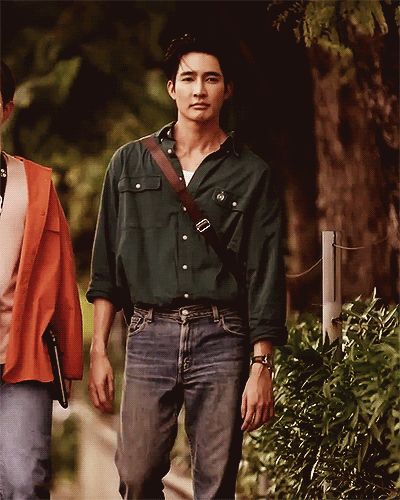

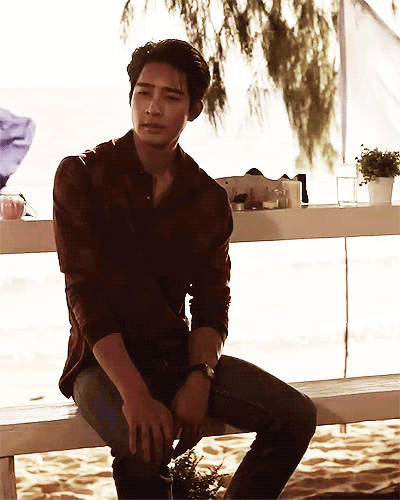


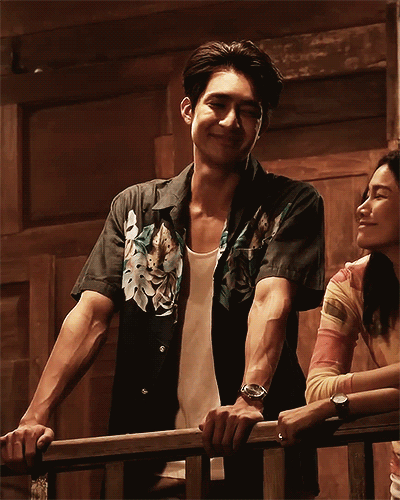
gmmtv + character fashion
↳ earth pirapat as "jim" in moonlight chicken (2023)
#moonlight chicken#moonlight chicken the series#midnight series#jim jaruek#earth pirapat#asianlgbtqdramas#gmmtvfashion#mygifs#ok so this was mostly an excuse to gif earth🧍🏻♀️#but in my defense they did give him a lot of nicely fitted shirts#he had a limited wardrobe (for obvious reasons) but it suited the character so well
421 notes
·
View notes
Text
Every Boromir hater makes my enormous love for him grow stronger. Sorry you couldn't understand him, I get him tho and we're holding hands and the whole of Gondor is laughing at you
#lotr#boromir#tbh i think id actually have a good time chatting w a boromir hater if they knew and understood the material but still hated him#cuz most people who dislike this man do because of very shallow reasons#'he was upset looking down at narsil' one can only wonder why that has baggage for a gondorian and the stewards son#'he didnt accept aragorn at first' yea i bet when a dirty ass ranger claims the throne of a kingdom without having lived there#when your fam took care of it for several generations it doesnt feel super great and you Might be a bit upset and worried about it#'he tried to take the ring from frodo' despite disagreeing w the councils decision he still earnestly followed them to destroy the ring#and he only fell after weeks of traveling as the ring whispered to him threats of destruction#one that unlike the rest of the fellowship was already Actively happening and had been happening for a long time#you see ur cities fall and people die everyday as the 1st line of defense against ultimate evil and we tell you not to use a perfect weapon#while said weapon tells you yes it will fix everything just grab it go on boy#and echoes words your father has been pushing onto you all throughout#it feels like people just have no sympathy compassion or understanding for all he's gone through or for the power of the ring#deep breath. im ok#im normal about boromir and my heart doesnt shatter at every rewatch of his death#id have followed you my steward.
260 notes
·
View notes
Text
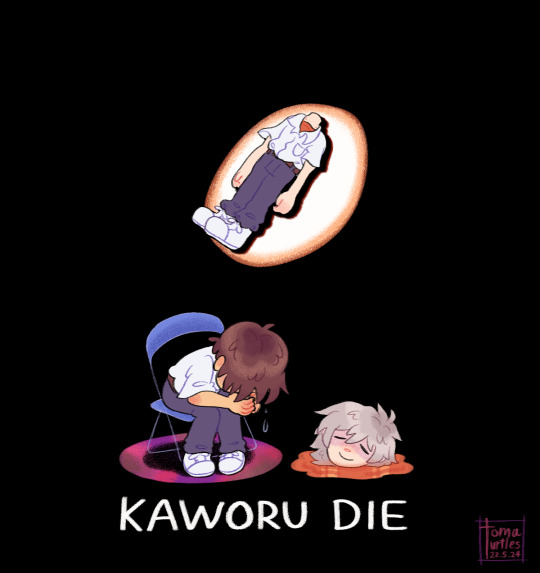
Got inspired by this and had to
#shinji ikari#kaworu nagisa#kawoshin#neon genesis evangelion#nge#toma draws#managed to set up my art stuff in the place we're staying at and immediately used it for evil#love how after kawoshin week i was like 'yay i can finally get to non kawoshin wips ^_^' only for it to be the first thing i draw after 😭#in my defense i also didn't get around to drawing for a while and kawoshin kept me going during the fuckass flood situation in my state#(i'm doing ok btw :3👍we have a nice place to stay while we wait it out and our house seems to be mostly water free despite water around it)#btw i forget if i mentioned it but i started posting art on twitter for kawoshin week and ended up sticking around after#so i'm also there now :] (i'm tomaturtles there too)#worry not though.... i may have been quiet on here lately but tumblr is still my house
360 notes
·
View notes
Text
it's a pet peeve of mine when ppl frame Andrew as hating Aaron and being needlessly cruel to him... bc while yes, their relationship is fractured and strained, Andrew genuinely cares about his brother and wants the best for him, he just doesn't know how to show that in a normal way.
like he might not know how to express it in a healthy manner but Andrew LOVES Aaron, like he truly just wants Aaron to be healthy and safe. It's like, his whole Thing. Aaron is one of the most important people in his life. Andrew wants him around. He'd do anything to protect him.
I guarantee Andrew wants to be emotionally close to Aaron too, he just doesn't have the tools to do that and the thought of letting someone in terrifies him. He also has no concept of what a healthy sibling relationship looks like, so he has no frame of reference to work from.
#i love bickering twinyards as much as the next guy but sometimes ppl write andrew has if he thinks aaron is a waste of space#and that just isn't true#andrew values his brother#he wouldn't insist on keeping aaron close if he didn't#when ppl do this is just so obvious to me that they're using andrew as a mouthpiece for their own dislike of aaron#and like ok yeah you're entitled to not like a character i guess#but it's just so wildly out of character to me for andrew to treat aaron like shit for no reason beyond Being Cruel#like yeah andrew can be mean when he's feeling defensive or trying to make a point#and yeah he can treat people like shit if he's got a reason to justify it like Keeping People Safe#but he's not needlessly cruel to the people closest to him without cause#like neil says#everything andrew does#he does For A Reason#even neil isn't needlessly mean to aaron tbh#like he doesn't like aaron much at certain points but if he picks a fight with aaron it's never without cause#and he's genuinely happy for aaron when things work out with katelyn in the end#and he wants aaron to have a relationship with andrew as well! like it's important to neil that the twins have a healthy bond!!#anyway im getting off my soapbox now this is just something i was thinking about today a Lot#aftg#all for the game#the foxhole court
512 notes
·
View notes